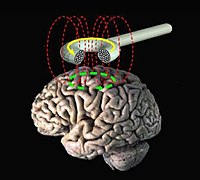
Photo from wikipedia
Amyotrophic lateral sclerosis (ALS) is a fatal neurodegenerative disease characterized by the selective degeneration of upper and lower motor neurons. Currently, there are no effective biomarkers and fundamental therapies for… Click to show full abstract
Amyotrophic lateral sclerosis (ALS) is a fatal neurodegenerative disease characterized by the selective degeneration of upper and lower motor neurons. Currently, there are no effective biomarkers and fundamental therapies for this disease. Dysregulation in RNA metabolism plays a critical role in the pathogenesis of ALS. With the contribution of Next Generation Sequencing, the functions of non-coding RNAs (ncRNAs) have gained increasing interests. Especially, micro RNAs (miRNAs), which are tissue-specific small ncRNAs of about 18–25 nucleotides, have emerged as key regulators of gene expression to target multiple molecules and pathways in the central nervous system (CNS). Despite intensive recent research in this field, the crucial links between ALS pathogenesis and miRNAs remain unclear. Many studies have revealed that ALS-related RNA binding proteins (RBPs), such as TAR DNA-binding protein 43 (TDP-43) and fused in sarcoma/translocated in liposarcoma (FUS), regulate miRNAs processing in both the nucleus and cytoplasm. Of interest, Cu2+/Zn2+ superoxide dismutase (SOD1), a non-RBP associated with familial ALS, shows partially similar properties to these RBPs via the dysregulation of miRNAs in the cellular pathway related to ALS. The identification and validation of miRNAs are important to understand the physiological gene regulation in the CNS, and the pathological implications in ALS, leading to a new avenue for early diagnosis and gene therapies. Here, we offer a recent overview regarding the mechanism underlying the functions of multiple miRNAs across TDP-43, FUS, and SOD1 with the context of cell biology, and challenging for clinical applications in ALS.
Journal Title: Frontiers in Neuroscience
Year Published: 2023
Link to full text (if available)
Share on Social Media: Sign Up to like & get
recommendations!